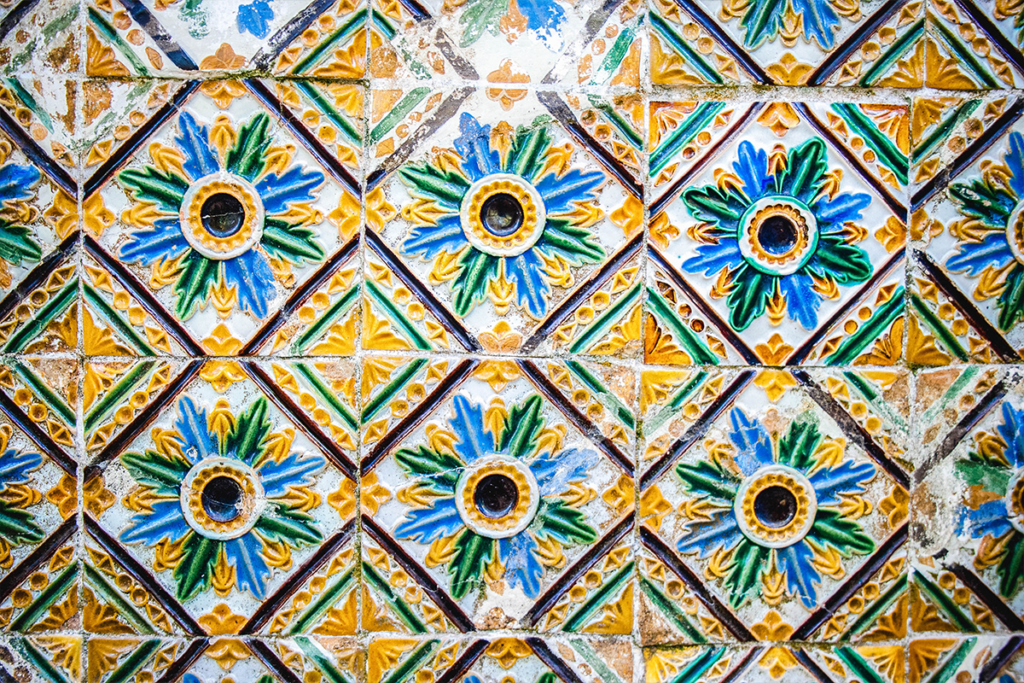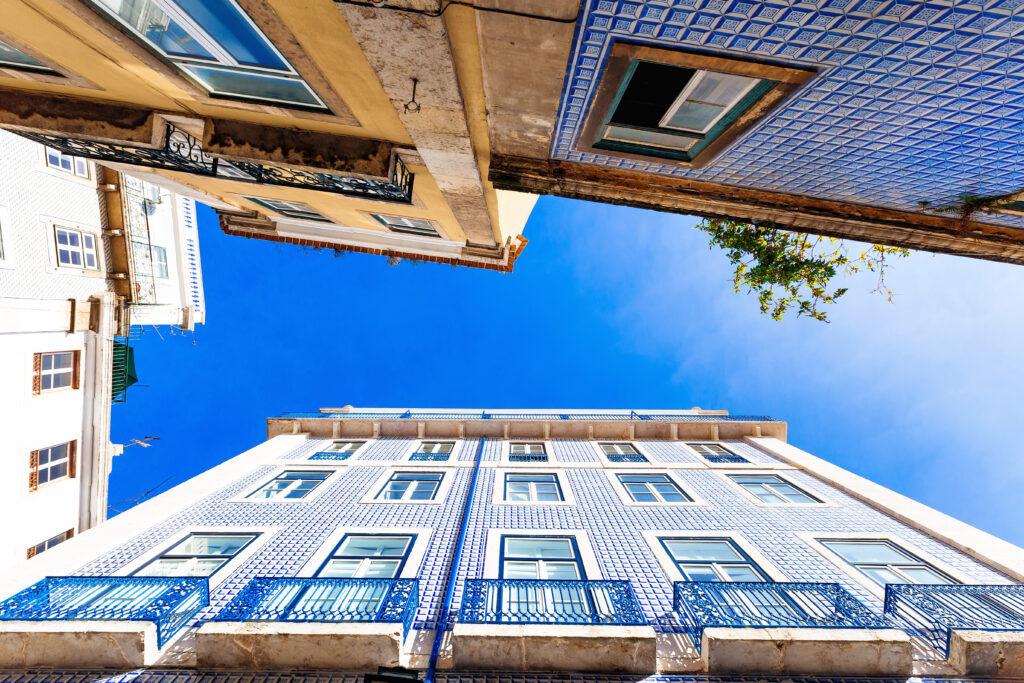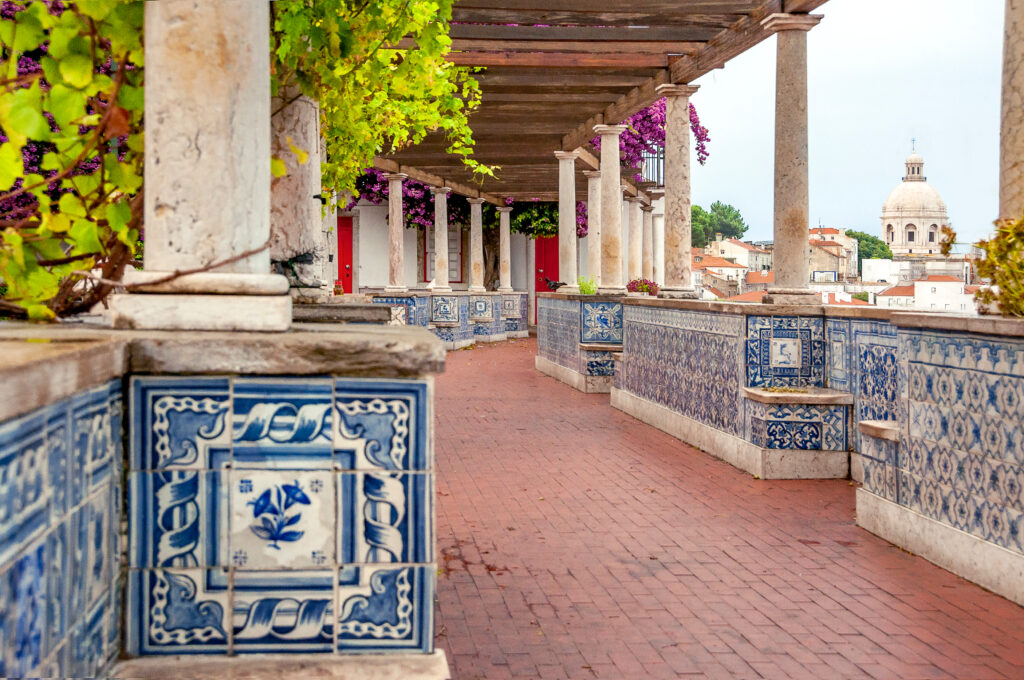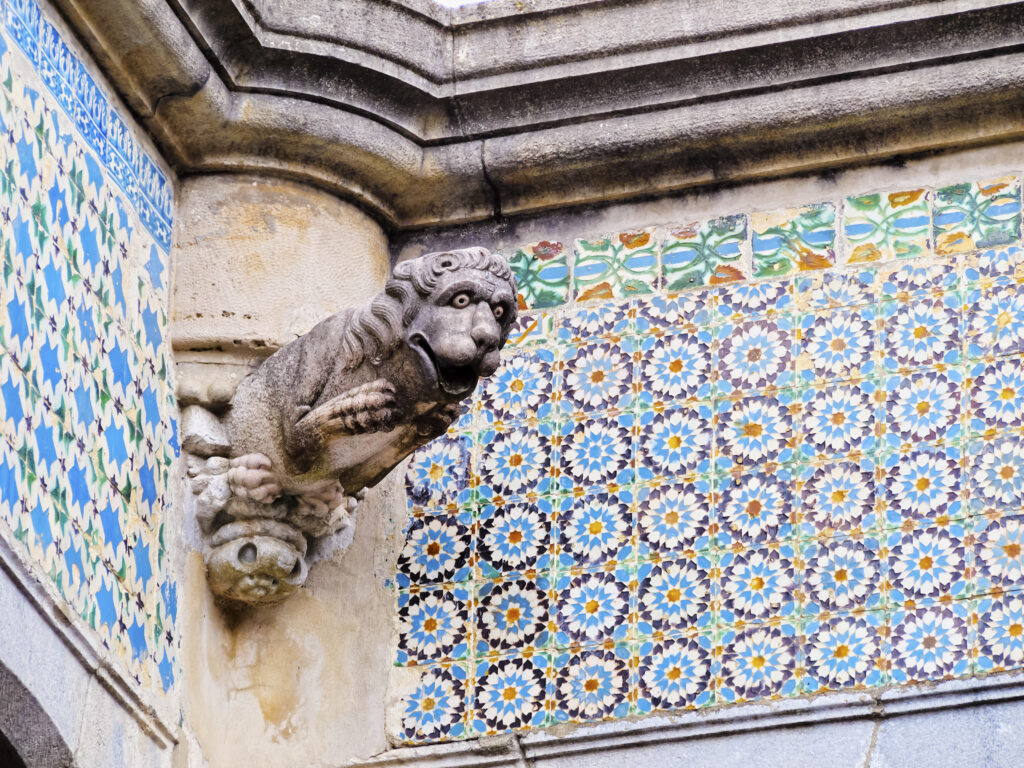
THE MAGNIFICENT TILE
It’s hard to resist falling in love with the azulejos (tiles) adorning the buildings of Lisbon. It seems cliché and obvious, but those tiles are ubiquitous and will overwhelm you with the sheer number of façades. Only a cold heart is impervious to their charm. And, most can be easily viewed from street level while pushing a stroller.
You will see tiles everywhere you go. So, it almost seems silly to suggest a tile walking route because any walking route automatically becomes a de facto tile walking route just by virtue of being in Lisbon! It would be like suggesting a blue sky walk, or a bacalhau restaurant walk – it will automatically happen! Instead, EFTF has highlighted a few areas in which to pay extra attention to the tiles. These areas can be folded into a day’s itinerary or be the target of a special trip by an especially smitten family member.
These are presented in descending order of appropriateness for children. It’s not that tiles aren’t appropriate for children; it’s more that kids aren’t doing cartwheels in excitement for them. And as we move down this list, the tiles can be within a child’s reach – breakable!
Chiado
This is probably the most dense and dynamic run of tiles in the entire city. The gritty exteriors near Bairro Alto give way to the immaculate tiles of the main shopping district of Chiado. Simply walking around this area will have you gawking and craning your neck. Nonetheless, here are a few places of note:
Livraria Bertrand: We love the repeating blue and white patterned tiles of the world’s oldest operating bookstore. If you purchase a book here, be sure to request a stamp turning your book into a souvenir.
Largo Rafael Bordalo Pinheiro: In the running for most-photographed building in Lisbon – for good reason. The oranges and yellows framing the mythological figures grab the viewer’s attention as much now as they did in 1863, when it was constructed.
Praça Luis de Camões: This is the epicenter of old Lisbon. Get in the middle of this square and take it all in. So much visual stimuli.

Tiles Decorating the Metro Stations
What the Metro lacks in some practicality for the visitor, it makes up for by virtue of each Metro station being its own art gallery. Roll through on the Metro for quick glimpses or get out and explore. Red line is the most modern and the tiles are clearly integrated into the overall station design. Blue line has the clearest set of themes at each station. Yellow and green lines have some of the original tile works in situ. The Metro fare is only €1.65 or included with an activated Lisboa Card.
Around the turn of the 20th century, a terrible thing happened. Tiles fell out of favor with the tastemakers of the day. Tiles were associated with the poor, so new construction ceased embellishing their buildings with the once beloved azulejos. The art form faded away during the century until visual artist, Maria Keil, was tapped to conceive art for the stations of the new Metro train line being constructed throughout Lisbon. From 1957 to 1972 she introduced a graphic interpretation of tiles that simply stunned the riders/viewers. The tiles were so popular that it was impossible to conceive of new stations along new Metro lines NOT having azulejos. Furthermore, tiles were re-established as an integral part of Lisbon’s heritage, to be preserved and appreciated above ground too.
Buildings in Largo do Intendente
There is a pocket of tiled exteriors near the Praça Martim Moniz that are some of the most beautiful and elaborate in Lisbon. They are a 1-minute walk south from Intendente Metro station (green line), a 3-minute walk north from Praça Martim Moniz, or a 15-minute straight line walk from Praça do Comércio – easy to find! There’s not much going on in this neighborhood other than this very specific area, so you’ll be making a targeted effort.
Along Avenida Almirante Reis is the delicate white and blue color palette of a recently retired ceramics factory called Fábrica Viúva Lamego. As you admire the façade, keep in mind you’re merely looking at the factory’s backside! Proceed around the block to a tiny plaza called Largo do Indendente. The factory’s front serves as an ode to Portugal’s history of trade with the East. This little plaza has embraced its azulejo notoriety with coffee shops, restaurants and a super-sized A Vida Portuguesa store (which alone could be worth the trip). This A Vida Portuguesa store sits in the old factory, so there are some in situ details that could never be replicated, so are best seen in person.
Within a hundred years of tiles being introduced to Portugal, factories like this began sprouting up. Tiles became synonymous with Portugal itself. It was determined the tiles were not just fashionable, they were practical. First of all, they kept façades from deteriorating. Limestone is the primary local building material, and it becomes worn and pockmarked by the weather over time. Tiles on the exterior of a building were also found to reduce humidity in the winter and keep things cool in the summer. As an added bonus they deflected street noise.
A Few Suggestions Near Praça do Comércio
If you’re on the low ground near Praça do Comércio we offer some dramatic tiled façades to check out. You can plug these coordinates into your phone and loop back within half an hour.
Rua das Cruzes Sé, 13 – 15: This is an easy one to begin your hunt. This building is adjacent to the Cathedral Sé. These tiles date back over one hundred years and illustrate the weighing scales that used to be produced in this factory.
Miradouro de Santa Luzia: We never said you weren’t going to go UPHILL. Follow the road to the left of Cathedral Sé, where the famous #28 trolley clanks along its track. Crowds gather for the Miradouro das Portas do Sol next door. And, you should certainly enjoy the great view – but only after you check out the tiles in this docile church garden. You’ll have to look down!
Rua do Milagre de Santo António, 14: Saint Anthony used to live nearby. So, this is a popular stop for pilgrims and tile pilgrims alike. The triptych of azulejos depict Saint Anthony’s ‘Miracle of the Fishes,’ ‘Miracle of the Jug’ and ‘Miracle of the Mule.’ Makes you wonder what the ‘Miracle of the Mule’ was all about.

Tiles Hidden All Over Alfama
Having survived the 1755 earthquake intact, Alfama is the oldest neighborhood in Lisbon. It is a quirky labyrinth of alleys and staircases that make specific navigation difficult because maps and the GPS on your phone can struggle to identify drastic changes in elevation. The best way to see the Alfama is to start at the top and meander down to the Tejo River. You will find idiosyncratic surprises in every wrong turn and dead end: tiles for house numbers, tiles commemorating loved ones, tiled walls and tiles with notes or poems.
The ambling downhill route may not fit your vibe for the day, especially if you have a stroller or children on the brink. There is nothing in the way of parks nor treats on the way down. This will test your all-terrain abilities as a family.
National Tile Museum
This museum is a bit out of the way. Its location is an outlier as compared to the other central Lisbon sites, so it will require some extra logistics. That being said, it might not be something for the entire family, especially younger ones. This is the perfect ‘Divide & Conquer’ excursion for somebody in your crew who needs a morning or afternoon to his or herself. Located in a former convent, the Museo Nacional do Azulejo is a peaceful, reflective setting. Catch the #759 bus in Praça do Comércio (toward Estação Oriente) for a 15-minute ride along the Tejo (get off at Igreja Madre Deus). Or, treat yourself to a short cab ride or Uber.

The first tiles were brought to Portugal from Spain. When King Manuel I was decorating his palace in nearby Sintra he accented some rooms in a manner reminiscent of the Alhambra – azulejos in colorful repeating geographic Moorish patterns. From that point forward Portugal, and especially Lisbon, was hooked on tiles.
Be sure to check out the pizazz of the attached Church of Madre de Deus. This church was originally built in the humble Mannerist style in the 1500s. That style was tossed out the window in the 1800s when riches from Brazilian diamond and gold mines poured in. The result is the busy Baroque adornment with tile motifs and endless gold leaf. This church just hits differently than most. Perhaps this is because of the astounding amount of decoration in a more human scale setting. Sit in a pew and imagine the unseen, cloistered nuns signing from the choir above.
The azulejos tell a story as you move room to room in the museum. The tiles through the centuries double as historical earmarks. Case in point, there is a jaw-dropping 23-meter panoramic depicting 13km of Lisbon coastline along the Tejo River that predates the 1755 earthquake. Key recognizable landmarks include Tower of Belém, São Jorge Castle and the Madre de Deus Convent (the convent that now houses the museum you’re standing in!) This piece alone is worth the journey.
Note: The museum is open 10:00 am – 6:00 pm, admission closes from 12:30 pm – 2:00 pm so the ticket sellers can take a proper lunch break. Once you’re inside the museum, you’re good to go. Closed Mondays. €5 admission, children under 12 free. Free with a Lisboa Card.
Surrealejos
You’ve hopefully seen plenty of the old; now meet the new. Surrealejos is a portmanteau mash-up for surrealism and azulejos. This perfectly describes this project by Italian artist Luca Colapietro. The tiles are bizarre, outlandish, odd yet very cool. We recommend keeping an eye out for his work when out and about. He does keep a tiny store at Rua Presidente Arriaga, 100, which is in the Alcântara neighborhood.
Solar Antiques
Should you find yourself up at Miradouro de São Pedro de Alcȃntara – and you will – shoot down Rua Dom Pedro V a few blocks to Solar Antiques. This antique store deals exclusively in ceramics, especially of the tile variety. There are tiles and sets of tiles demarcated by century. Need a tile from the 1500s to accent your kitchen backsplash? This is where you would find it. It’s an impressive collection, even if you’re just ‘browsing.’
Public service announcement: If you are shopping for older tiles, do not buy them at flea markets or from people off the street. Those are often tiles stolen off of buildings.
Be warned, Solar Antiques might not be the store for everybody. You’ve heard of a bull in a china shop? Well, you might not want to bring your little bulls into this ceramic shop. We’re pretty sure the “you break it, you buy it” policy began in a store like this. Open 10:00 am. Closed for lunch 1:00 pm – 2:00 pm daily. Saturdays closed at 1:00 pm. Closed Sundays.